As the leading POS providers in the eCommerce market, Lightspeed vs Shopify offers a range of powerful functions to attract customers to your store. And yet, we know many of you are still struggling to find the key differences between these platforms or choose the one that suits their business best.
For detailed answers, let’s follow our evaluations below! In this article, LitExtension will present a detailed Shopify vs Lightspeed comparison by discussing:
- A quick summary of the two platforms
- Which platform is the optimal choice for your business, Lightspeed or Shopify?
- Detailed comparison between Lightspeed and Shopify
Lightspeed vs Shopify: A Quick Summary
What is Lightspeed?
Since its 2005 release, Lightspeed has been a leading cloud-based eCommerce solution that unifies point of sale (POS) and payments. Nearly 168,000 worldwide retailers have been using Lightspeed, making it one of the promising platforms for merchants.
Basically, Lightspeed provides 9 different versions; however, 8 series of them were developed to serve retail activities. That’s also why many sellers call it Lightspeed Retail.
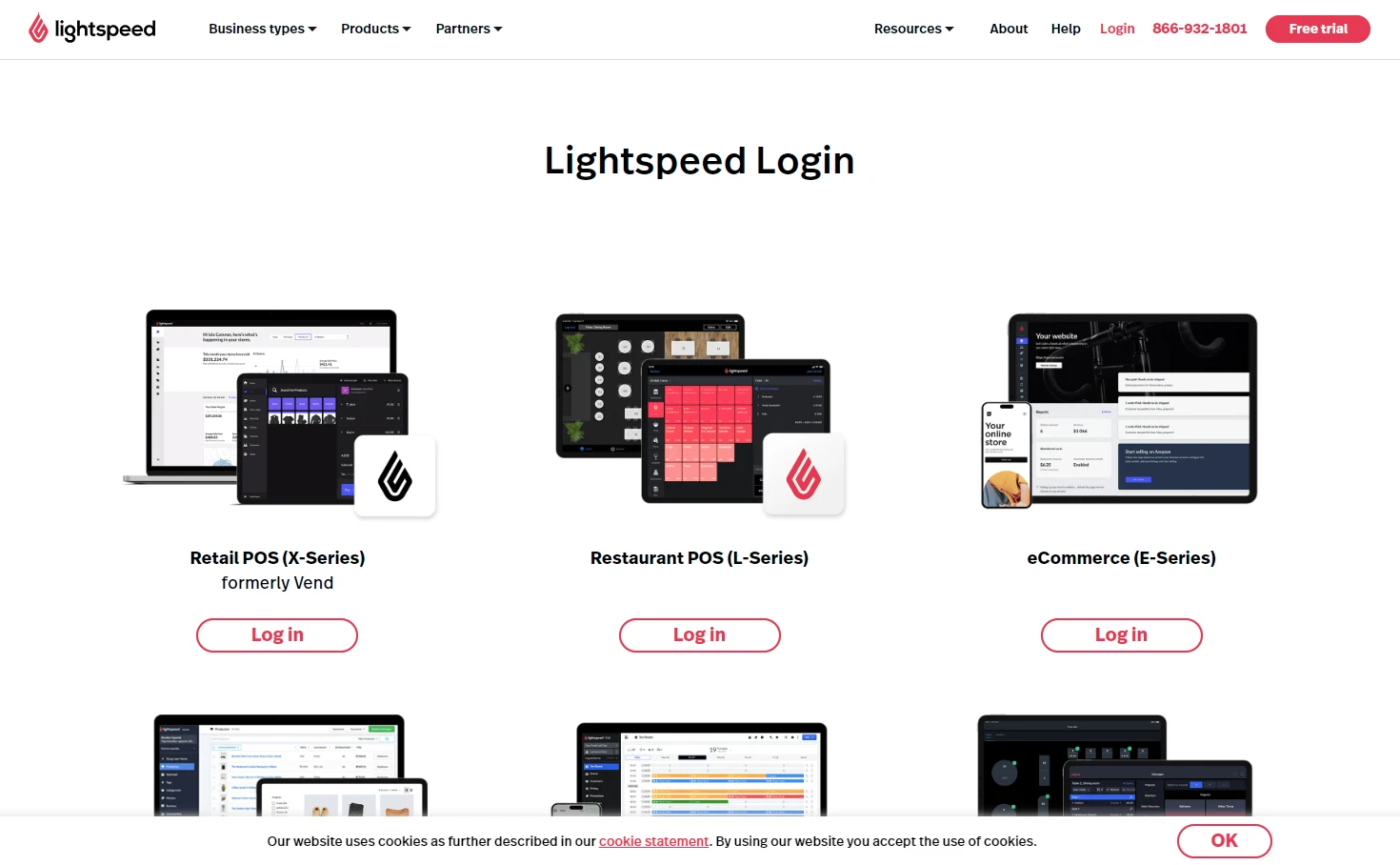
Besides that, Lightspeed stands out with powerful features like inventory and retail store management, cash drawer control, and especially POS hardware. It is a great chance to manage online and offline stores effectively.
Pros | Cons |
|
|
What is Shopify?
Founded one year after Lightspeed (2006), Shopify is an all-in-one eCommerce solution convenient for growing online businesses. This platform currently powers over 5 million live websites from different fields.
Also, Shopify offers strong support for point-of-sale (POS) systems that work seamlessly with both iOS and Android. Indeed, the mobile app allows you to easily sync your account and manage orders across all your sales channels. And if you need any POS hardware, feel free to purchase it directly from Shopify stores.

Take a look at the table below for all the Shopify advantages & disadvantages. In case you need an in-depth understanding of this platform, don't forget to refer to our Shopify reviews.
Pros | Cons |
|
|
Now, let’s keep walking with us to see a head-to-head comparison between Lightspeed vs Shopify.
Lightspeed vs Shopify: Which One to Choose?
After extensive research, I can say Shopify definitely comes out on top, though Lightspeed is still a very competitive platform.
In fact, both options have their strengths and are suited for different needs and audiences. Here’s a more detailed breakdown of which platform suits which type of users:
When to choose Lightspeed
In general, Lightspeed is the better choice if your business:
- Heavily relies on a robust POS system. Lightspeed offers tailored features and hardware that make in-store management more efficient.
- Has a complex and broad inventory. The platform excels in inventory management with advanced features like smart pricing assistance, kitting tools, and wastage tracking.
- Runs a brick-and-mortar store or a chain of physical stores. In these cases, you will likely need an integrated solution for both online and offline operations. Lightspeed proves a valuable choice in this regard.
When to choose Shopify
On the other hand, Shopify will work better for you if your business:
- Has a rather tight budget. Shopify offers more affordable pricing plans (starting at $19/month), making it an economical option for entrepreneurs.
- Needs extensive add-ons for scaling. Shopify offers a vast array of over 8,000 third-party apps and integrations, which makes it a far superior ecosystem to Lightspeed.
- Requires 24/7 support. Shopify does not disappoint here. It provides consistent, high-quality customer support with various contact methods, including social media.
8 Differences When Comparing Lightspeed vs Shopify
In our comparison, Shopify beats Lightspeed in 6 out of 9 categories, although Lightspeed also performs quite well, winning in 2 categories and tying with Shopify in one.
Below is a comparison table of Lightspeed vs Shopify, depending on the 9 different features:
Feature | Lightspeed | Shopify | Winner |
Pricing plans |
|
| Shopify |
POS system |
|
| Lightspeed |
Inventory management |
|
| Lightspeed |
Integrations & add-ons |
|
| Shopify |
eCommerce tools |
|
| Shopify |
Reporting & analysis |
|
| It’s a tie |
Marketing |
|
| Shopify |
Customer support |
|
| Shopify |
1. POS system (Lightspeed wins)
In the comparison of Lightspeed vs Shopify POS, we will evaluate the 2 main concerns: POS mobile app and POS hardware. In particular:
Lightspeed
1. Mobile app
Thanks to Lightspeed’s constant updates, you can use cloud-based mobile POS (mPOS) to make your retailing activities more flexible and secure.
Nevertheless, this solution doesn’t support barcode scanning (meaning you must register for extra apps to optimize your store’s mobile transactions). Also, Lightspeed POS will charge you different pricing levels depending on the number of locations and registers. For example:
- If you only have one location and register, you must pay $69 to $189/month to use the POS system (in the United States).
- With the Enterprise package, you need to contact the Lightspeed team for the final quote.
Don’t forget to consider Lightspeed processing fees, starting from 2.6% + 10¢ per transaction.
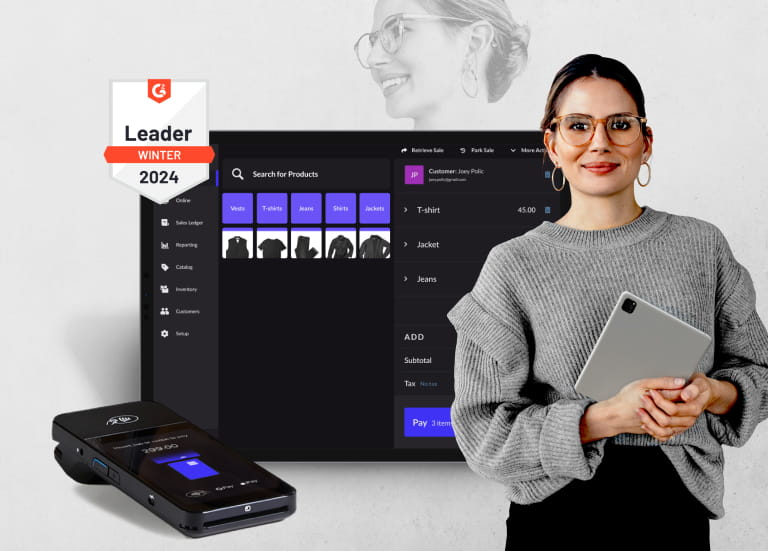
2. Hardware
Regarding Lightspeed hardware, you can set up a POS system by using one of the 2 following hardware bundles:
- iPad hardware kit: LAN receipt printer, cash drawer, Bluetooth scanner, Lightspeed iPad stand, and Receipt paper
- Desktop hardware kit: USB receipt printer, Cash drawer, and USB scanner.
In case you don’t need an entire hardware package, you can take any individual POS equipment.
Shopify
1. Mobile app
When it comes to Shopify mPOS, you can freely customize your checkout to give your customers a better experience. This POS can be used for both iOS and Android, making it a breeze to activate your store’s POS across multiple devices.
Plus, you only need to pay from $5 to $89 monthly for your business to use a POS in person. That said, the transaction fee is higher than Lightspeed (2.9% + 30¢ USD online; 2.6% + 10¢ USD in person).
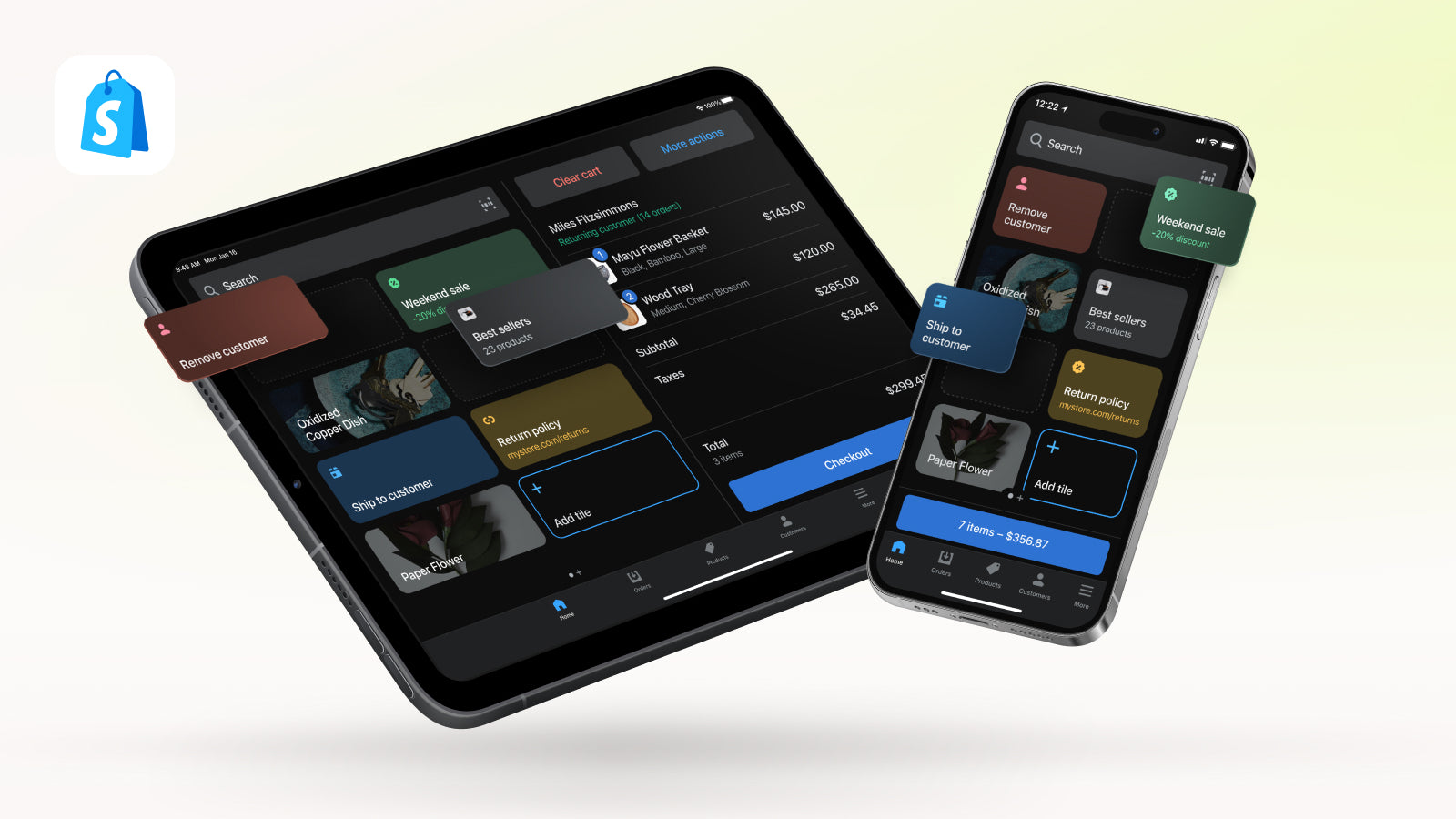
2. Hardware
Unlike with Lightspeed, we do not find any available POS hardware package. Fortunately, you can still buy the necessary items individually. Below are some of the most common POS hardware devices on Shopify:
- Tap & Chip card reader
- Countertop Kit
- POS Go
- Tap to Pay on iPhone
- Shop barcode scanners
- Shop receipt printers and cash drawers.
The Verdict
Overall, Lightspeed apparently beats Shopify thanks to its POS-tailored features and excellent POS hardware bundles.
2. Pricing plans (Shopify wins)
As of this writing, both Lightspeed and Shopify offer users free trials. However, there are some pricing differences between Lightspeed vs Shopify. Now, keep scrolling to discover more!
Lightspeed
With this platform, you can try Lightspeed Retail for free for 14 days without a credit card or commitment. So far, LightSpeed has provided 3 distinctive types of plans: Retail, Restaurant, and Golf, with each type further categorized into smaller groups.

1. LightSpeed Retail:
- Basic (for independent retailers and everyday needs): $89/month
- Core (for growing businesses seeking management tools): $149/month
- Plus (for higher-level customization): $239/month.
2. LightSpeed Restaurant:
- Starter (for daily operations): $69/month
- Essential (for more complex customer expectations): $189/month
- Premium (for multi-department connections): $399/month
- Enterprise (for advanced, larger-scale customization): Customized.
3. LightSpeed Golf:
- Personalized quote.
Shopify
With Shopify, you can experience the platform for free within 3 days. After that, you can extend the trial period for one month at only $1.This offer is a great chance to discover how Shopify works and familiarize yourself with its dashboard.
From our research, there are 2 types of Shopify pricing plans as follows:
1. Selling in Person (POS):
- Starter (for selling in social): $5/month
- Retail (for selling at retail stores): $89/month
2. Selling Everywhere:
- Basic (for solo entrepreneurs): $25/month
- Shopify (for small teams): $65/month (down to
- Advanced (for growing businesses): $399/month
- Shopify Plus: Prices vary depending on specific needs, starting from $2300 /month
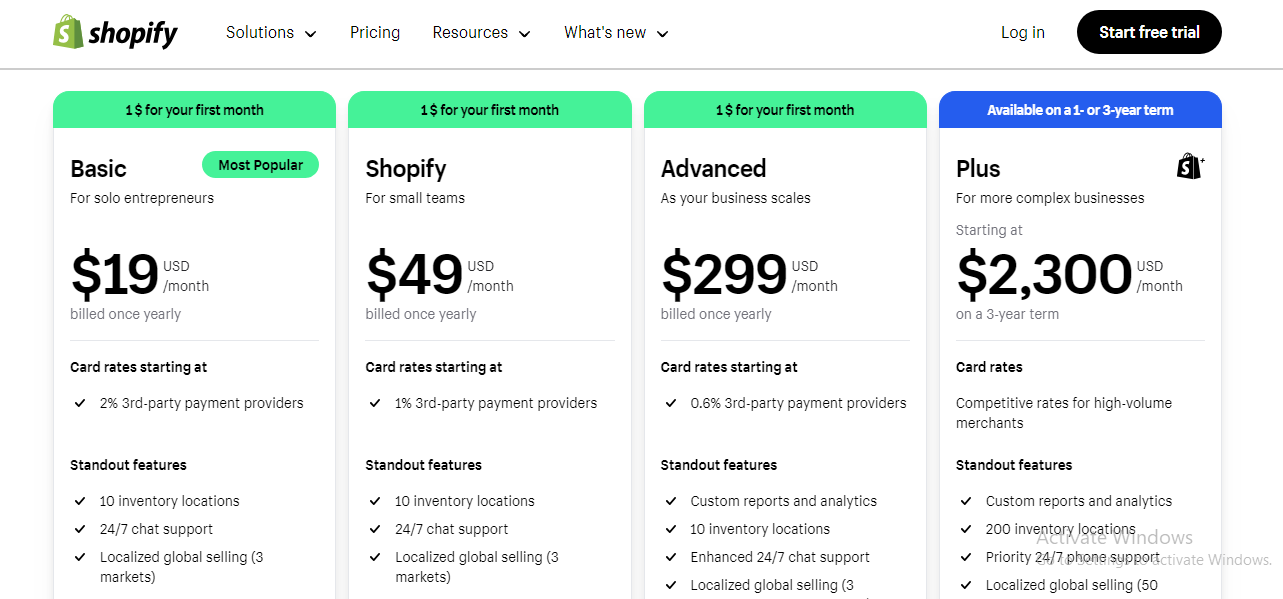
And here’s some great news: if you choose to pay yearly, the subscription fees for Selling Everywhere will be reduced to $19/month (Basic), $49/month (Shopify) and $299/month (Advanced).
The Verdict
When comparing pricing plans between Lightspeed and Shopify, we see that Shopify is more affordable than Lightspeed. With only $19/month, you can easily start your official online business.
Want to Migrate to Shopify?
If you intend to migrate to Shopify , LitExtension offers a great migration service that helps you transfer your data from the current eCommerce platform to a new one accurately, and painlessly with utmost security.3. Inventory management (Lightspeed wins)
Another issue we will discuss concerns Lightspeed vs Shopify stock (inventory), which is one of the biggest differences between these platforms.
Lightspeed
It's safe to say Lightspeed offers one of the best inventory systems. This solution provides powerful inventory features that can improve and smooth your management process, such as:
- Smart pricing assistance
- Kit tools
- Wastage tracking
- Multi-managed inventory
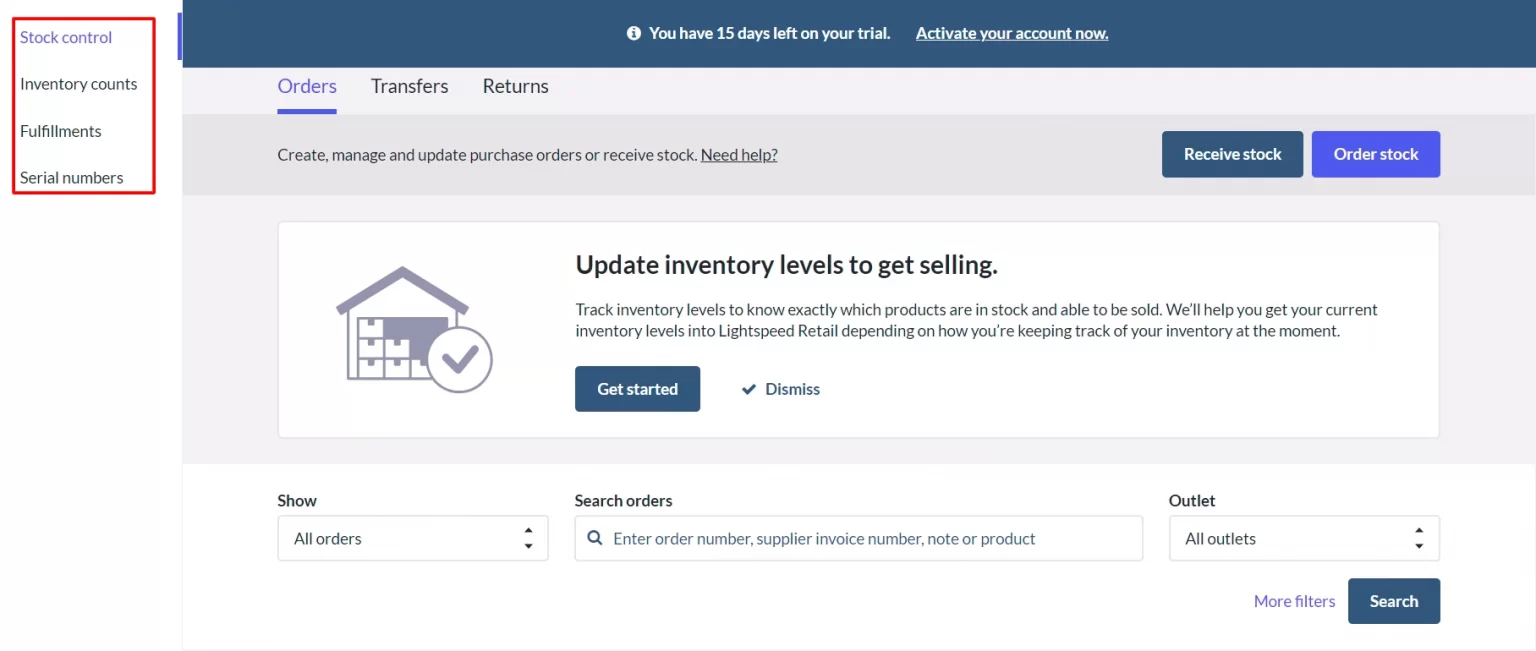
Shopify
On the contrary, you'll need an additional integration or advanced package to optimize your inventory management when selling on Shopify.
For example, to have a customizable stock matrix, it's required to register for POS Pro. Or, if you want to set up inventory-relating alerts, you'll have to employ the Stocky app. And, of course, that means you need to pay extra to satisfy these requirements.
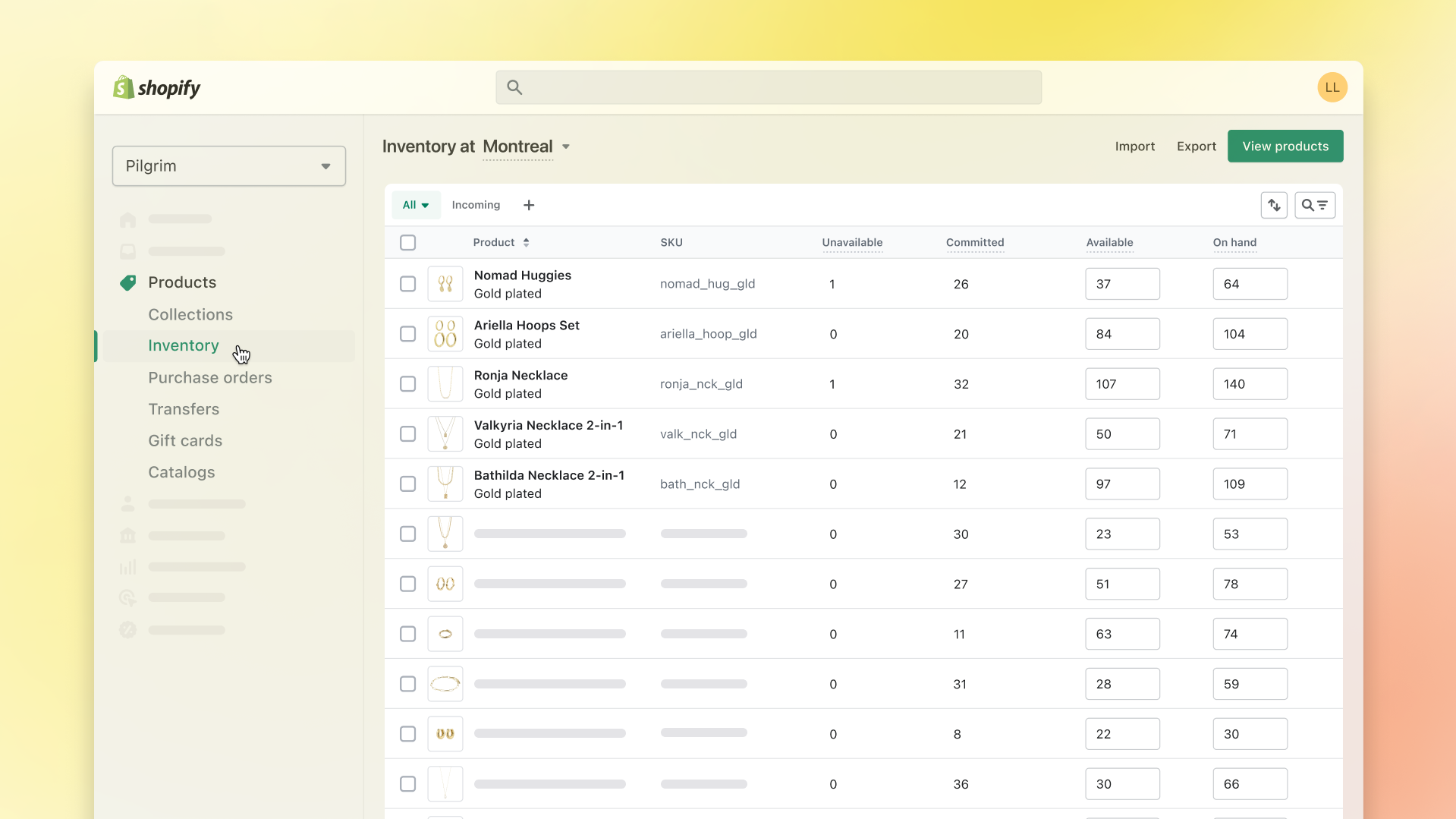
The Verdict
In our comparison of Lightspeed vs Shopify, Lightspeed has a convincing win thanks to its outstanding features like smart pricing assistance, kitting tools, and wastage tracking.
4. Lightspeed vs Shopify Integrations & Add-ons (Shopify wins)
Both Lightspeed and Shopify can provide a wide collection of third-party integrations. If so, what is the difference here? Let's discuss.
Lightspeed
So far, the Lightspeed App Store offers around 145 apps, which is relatively modest compared to many other major platforms.

Its available filters are also fairly basic, as they only allow you to sort by category, price, and alphabetical order. Aside from that, you can't see much else (e.g., trending apps during a particular month or popular plug-ins among stores similar to yours).
Shopify
By contrast, Shopify provides over 8,000 apps covering various aspects like selling, design, marketing, inventory, orders, shipping, and searching. You can use both free and paid apps to optimize your store’s performance.
Furthermore, I appreciate that Shopify lets us see trending and popular apps, which makes it very easy for beginners to navigate. As mentioned earlier, this feature is currently missing in the Lightspeed store.
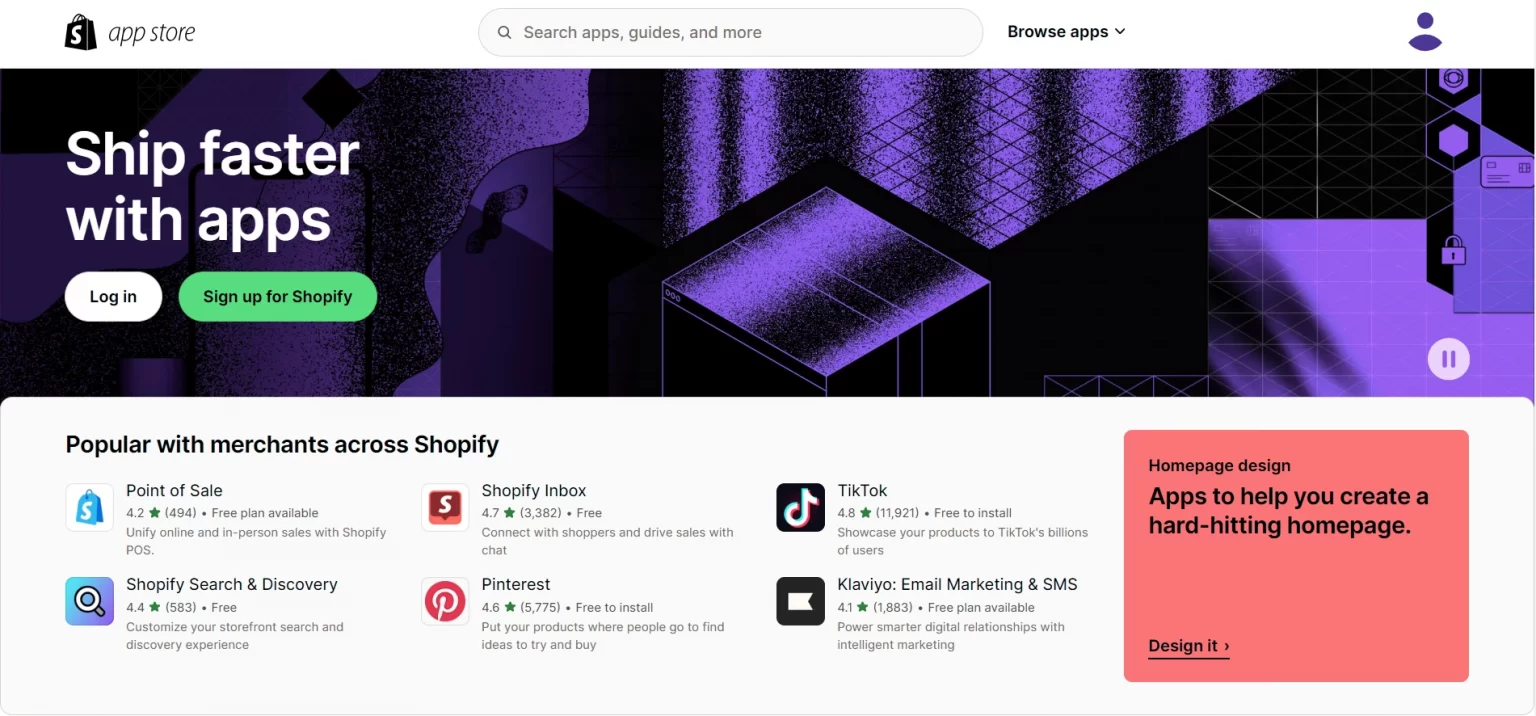
The Verdict
Regarding the integration ability and the number of apps, Shopify is more advantageous than Lightspeed, with 8,000+ available options.
5. eCommerce tools (Shopify wins)
To improve your store's sales effectively, it's necessary to invest in eCommerce values. Here are some highlighted aspects of Lightspeed vs Shopify's eCommerce tools you should consider:
Lightspeed
With Lightspeed, you can easily access the basic features to start your offline or online store. For example, you may import stock from any source and create bespoke discount codes to encourage your customers to shop. Regarding shipping and payment, we recommend using Lightspeed Payment and Shipstation or EasyPost shipping providers.
Furthermore, a strong focus on customer experience is one of its outstanding strengths.
Setting up a checkout dashboard, for instance, is incredibly simple. If you do not like its latest design, just return to the previous one by clicking the “Switch back to old checkout” button. Even better, Lightspeed lets you create quick customer groups, manage customer privacy requests, and effortlessly give and track gift cards to strengthen buyers’ loyalty.
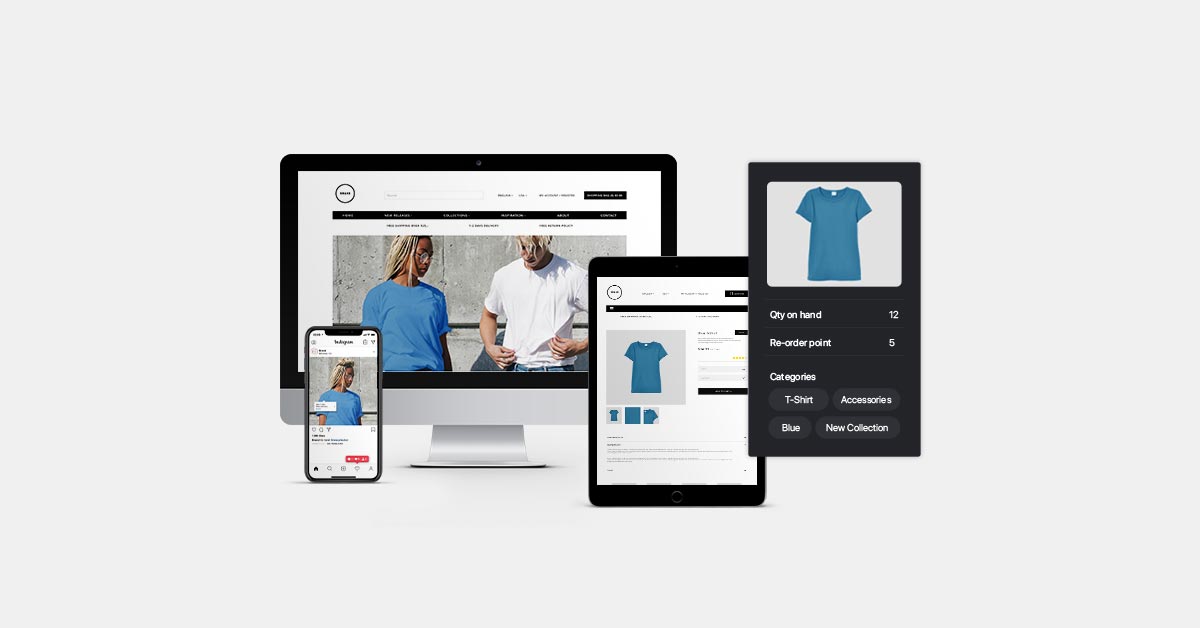
Nevertheless, there are a few downsides. For one, Lightspeed Payment is only available in the United States. Secondly, Lightspeed is a POS-tailored solution, which means it lacks powerful features like cross-channel or online marketplace sales.
Shopify
On the other hand, Shopify is an all-in-one eCommerce-tailored solution. With a range of great tools and an intuitive dashboard, you can analyze your business in-depth and manage it easily.
Besides that, Shopify allows easy integration into multiple eCommerce platforms and sales channels. That's why it has a huge advantage over LightSpeed in multichannel selling, not to mention the hundreds of multichannel-selling apps on the Shopify App Store.
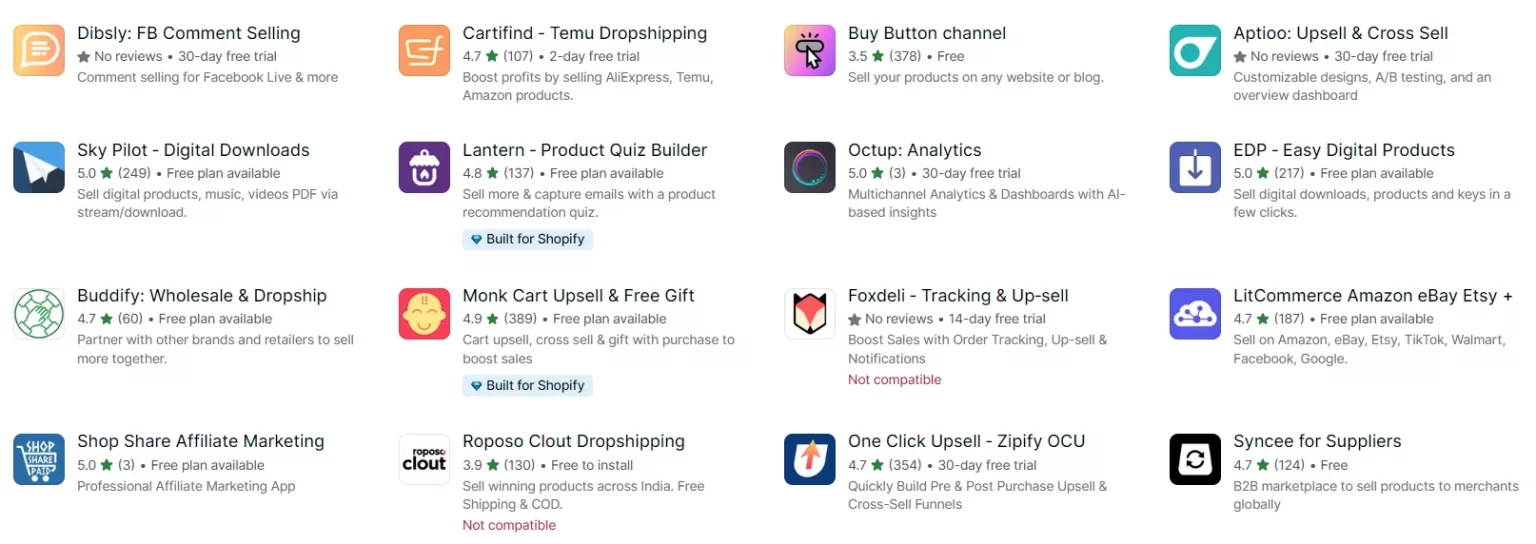
Most importantly, unlike Lightspeed, Shopify's in-house payment method, Shopify Payments, is available in 23 countries. Given this inclusive support, you don't need to pay transaction fees like external payment gateways, which helps you save your budget effectively.
The Verdict
In this round, Shopify certainly does better than Lightspeed. It comes with far more powerful eCommerce features, especially when it comes to multichannel selling.
6. Reporting and analytics (A tie)
When it comes to reporting and analytics on your store’s performance, the more data you have, the better insights you get. If so, which option is a winner in this aspect?
Lightspeed
We are quite impressed with Lightspeed in this regard. The solution provides a range of powerful reporting tools and over 40 available report templates. That’s why you can use Lightspeed to complete the majority of tasks, including:
- Remove dusty inventory
- Control the store’s interactive dashboards
- Measure/forecast customer demand
- Remove dusty inventory.

Shopify
Like Lightspeed, Shopify supports many basic reporting functions. Feel free to use Shopify to report your store's sales, category performance, or general fields.
Even better, if you are selling with higher plans, Advanced or Shopify Plus, there's the option to customize your final reports. You can freely design or modify anything to improve their displays and outlooks.
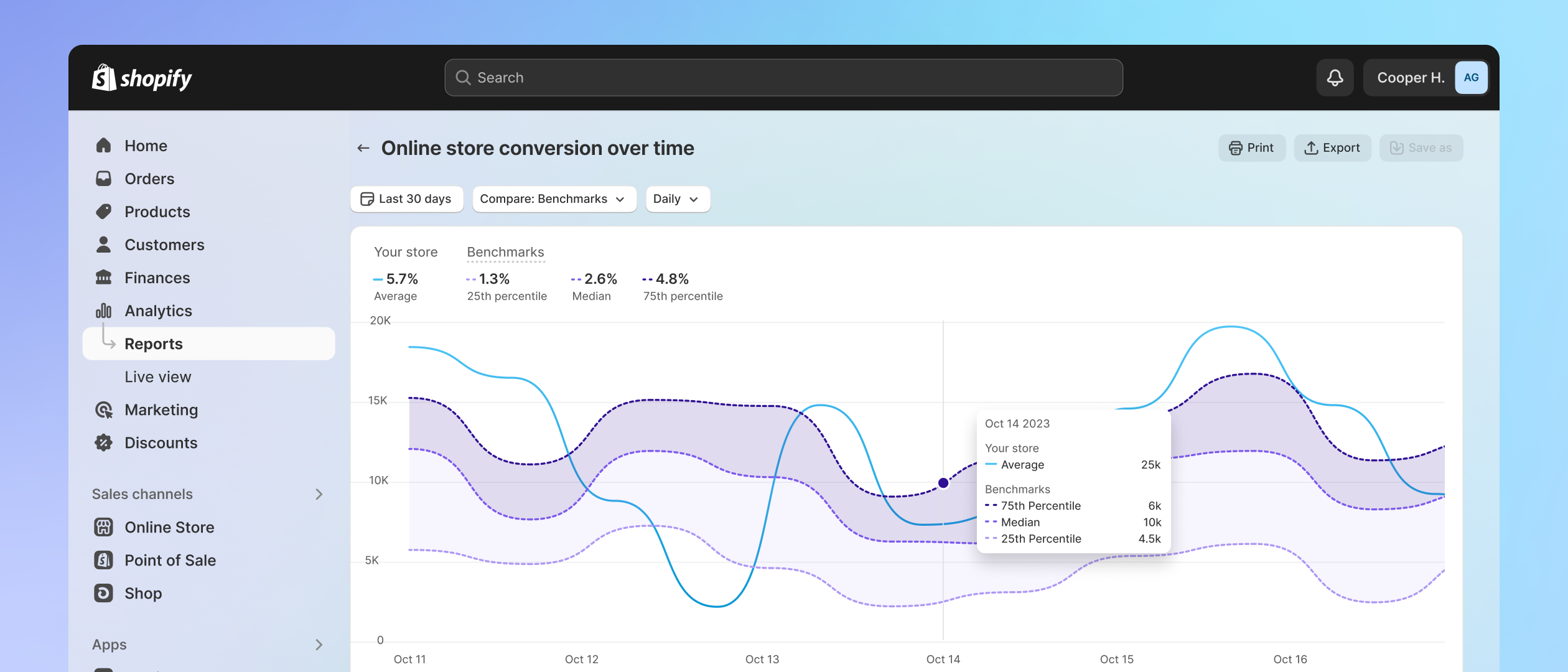
The Verdict
From what we can see, both Lightspeed vs Shopify offer users full features to optimize their sales reports. Thus, it's difficult to pick a winner in this situation.
7. SEO & Marketing features (Shopify wins)
Let's continue our comparison by closely examining SEO and marketing features. We will discuss what Lightspeed vs Shopify has to offer to boost your business's promotion strategies.
Lightspeed
You'll be delighted to know that Lightspeed eCom offers various marketing tools to empower your business effectively.
To attract more public attention, you can advertise on Facebook, connect your new feed to Instagram, or launch a TikTok channel. Moreover, it's possible to grow your store faster using Google tools and email marketing campaigns.
Nevertheless, I must say there aren't many special SEO features. The platform does offer some general tutorials and a step-by-step guide for editing the robots.txt file (to manage web crawlers), but that's about it.
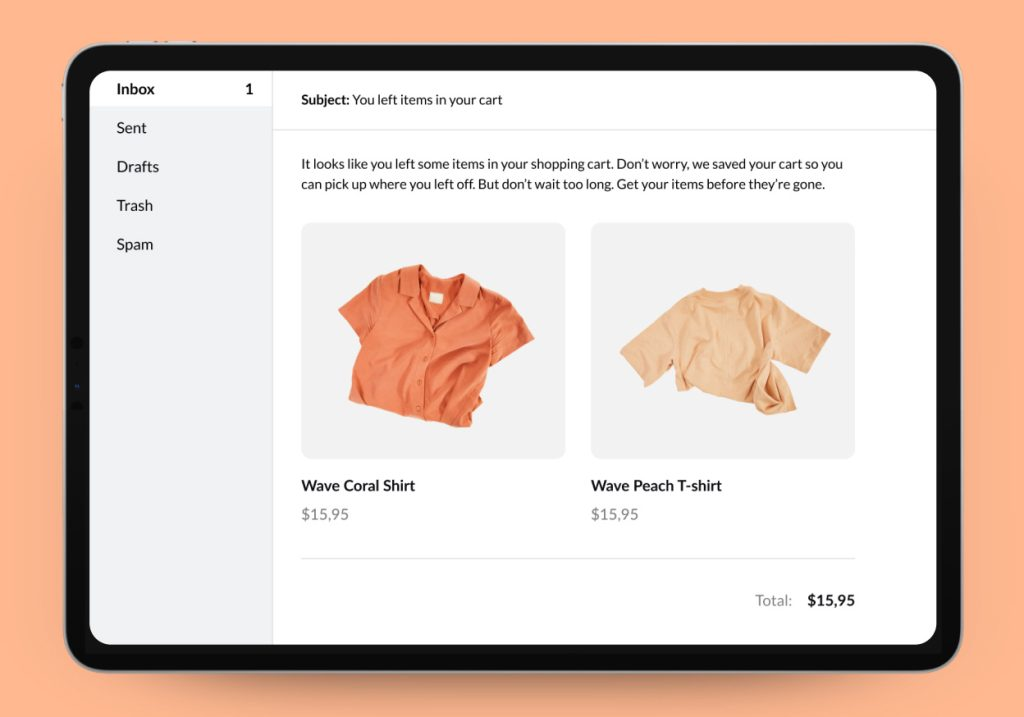
Shopify
When it comes to marketing features, Shopify is rated slightly higher than Lightspeed. The platform offers a fully functional tool list together with automated chats, ideal for improving customer experience at important touch points.
However, in terms of SEO, Shopify is pretty similar to Lightspeed, meaning it doesn't have many special built-in features to count on. That explains why most business owners prefer using third-party apps to boost their store's ranking on Shopify (Want to know which apps to use? Check out 15 best Shopify SEO apps).

The Verdict
Thanks to its high response and automation, Shopify brings more marketing value than Lightspeed. Still, both platforms have much room for improvement regarding SEO features.
8. Customer support
In the final section of our comparison of Lightspeed vs Shopify, we will discuss their customer support.
Lightspeed
It's easy to contact the Lightspeed support team 24/7 through various methods like the Help Center, live chats, or phone. Furthermore, with the Help Center, Lightspeed divided all common issues into 9 main categories, which is great for finding proper answers.
That said, the quality of responses from Lightspeed's customer service is not consistent. Most of the answers are not clear enough to fix your store's current issues.
Shopify
Once again, Shopify beats Lightspeed in this case, thanks to its consistent support and plenty of contact methods. Plus, one of the most interesting points about Shopify customer support is its support service through social media. Your connecting process with the Shopify team will be smoother and far more flexible as a result.
The Verdict
In terms of customer support, Shopify convincingly beats Lightspeed, impressing merchants with consistent and high-quality services.
Lightspeed vs Shopify: FAQs
Is Lightspeed better than Shopify?
The answer depends on your specific requirements when building a store. In case you prefer dedicated inventory management, it’s ideal to get Lightspeed Retail due to its more robust stock tools compared to Shopify. Or else, Shopify is an optimal solution for multichannel sales, and dropshipping companies.
What platforms and browsers does Lightspeed support?
As of this writing, Lightspeed supports the following browsers: Google Chrome, Apple Safari, and Microsoft Edge.
Is Lightspeed good for small businesses?
Definitely yes. You can use Lightspeed to run small businesses effectively. Basically, this platform doesn’t require much effort to set up a physical POS system. Plus, you can experience a 14-day trial to get familiar with how Lightspeed works.
Can Shopify connect to Lightspeed?
Absolutely yes. Indeed, the question is similar to “Does Lightspeed work with Shopify?”. Only by using a third party like LitCommerce, can you easily connect the Lightspeed POS system with the Shopify eCommerce platform.
Conclusion
This article has provided a detailed comparison of Lightspeed vs Shopify. We hope it helps you understand how each of them works and which is the best fit for your business.
If you decide to switch from LightSpeed to Shopify, the winner of our comparison, yet don't know how to, we're here for you! Over the past 12 years, our team has successfully assisted migrated hundreds of thousands of Shopify migration processes. Plus, our experts are available 24/7 to support you in every step.
Check out our blog and Facebook Community Group for more information.

